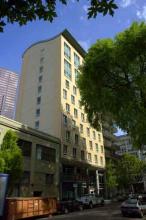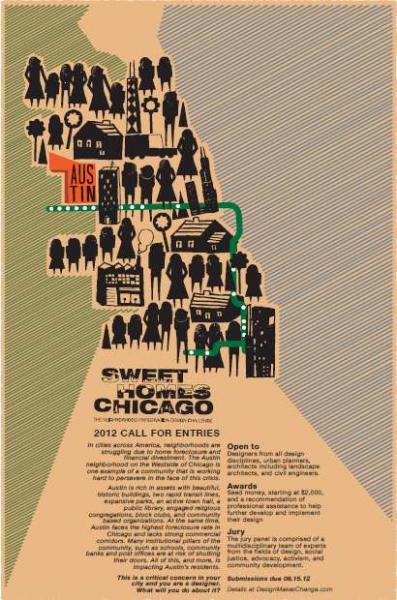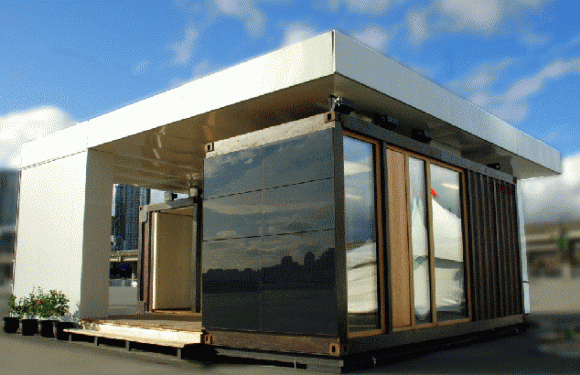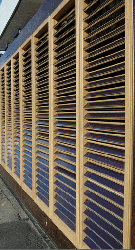Blog Post: Green Building Blog

By Paul Kilpatrick
Sweet Homes Chicago Design Competition
New Ways of Thinking About Water Usage
Sustainability Lessons from Sweden
Affordable Housing: Tackling Homelessness and Poverty in Portland's Pearl District
The Living Building Challenge - Cascadia Region GBC CEO Jason F. McLennan
---------------------------------------------------
SWEET HOMES CHICAGO design challenge
On the heels of their successful 2011 The Air We Breathe competition addressing air quality issues in two Chicago neighbourhoods, Chicago design initiative Design Makes Change announced a new competition for 2012 called Sweet Homes Chicago: The Neighbourhood Preservation Design Challenge which invites design professionals to tackle the growing instability resulting from economic challenges negatively impacting the neighbourhood of Austin.
Design Challenge:
Sweet Homes Chicago; The Neighborhood Preservation Design Challenge, will address the issue of foreclosure in the community area of Austin on the Westside of Chicago. This contest is open to anyone, both students and professionals. The winner or winning team will receive $2,000 in seed money and all strong entries will be part of a gallery exhibition in September. All the information is available on the Design Makes Change website: www.designmakeschange.com.
The (soft) deadline is August 15:
The goals with this contest are to:
1. Challenge local architects, designers, and engineers to think about the issue of foreclosure as it relates to their work and field;
2. Raise awareness through a contest, exhibition, and symposium on this issue;
3. Implement one exceptional, highly feasible design proposal (no matter how big or small) that helps to solve this crisis.
Project Brief can be found here:
http://www.designmakeschange.com/images/SHC/SHC_ProjectBrief%20copy.pdf
Das Haus tour
 German innovation and technology for residential buildings and solar energy use is featured in Das Haus Tour (The House Tour), a traveling pavilion currently on a demonstration tour across North America. The Tour, featuring the Das Haus pavilion, provides a glimpse at some of the operational energy savings and advanced sustainable construction practices being utilized in Germany.
German innovation and technology for residential buildings and solar energy use is featured in Das Haus Tour (The House Tour), a traveling pavilion currently on a demonstration tour across North America. The Tour, featuring the Das Haus pavilion, provides a glimpse at some of the operational energy savings and advanced sustainable construction practices being utilized in Germany.
Reducing energy demand and optimizing on-site energy production are paired design and construction goals on display. The Das Haus pavilion combines several features to achieve maximum energy efficiency, including Passive Haus design standards, a thin super-insulated envelope, heat recovery cooling and ventilation, thin film photovoltaics, solar façade, and triple pane windows.
The inspiration for the Das Haus pavilion design came from the winning German entries in both the 2007 and 2009 US Department of Energy Solar Decathalon[1], held in Washington, D.C. The biennial competition is a program to challenge collegiate teams to design, produce and operate solar homes, with the winning entries demonstrating the best of affordability, appeal, and maximum energy efficiency.
According to Das Haus Project Coordinator, Meredith Marsh, “after winning back-to-back competitions, the German government decided they wanted to celebrate these wins, and design this pavilion [Das Haus] that we have here.” March added, “Professor Manfred Hegger was the faculty advisor for the student teams from Darmstadt Technical University that designed the two winning Solar Decathlon entries. He and his wife are both architects, and they were approached to design this pavilion. So it does take some of its design cues from the Solar Decathlon homes, however it really is designed as a mobile exhibition of our current technologies and techniques and not as a full home per se.”
The house is designed for mobility, essentially acting as its own shipping container, and can be put together in just a couple of days.
The pavilion features energy efficient designs on the inside, including demonstrations of a variety of wall constructions, and energy producing technology on the outside. The renewable energy systems on the outside of the pavilion feature photovoltaics. (There is no solar thermal energy utilized on the presentation pavilion as it was not practical to set up for a travelling house.)
André Harrmann, Project Support & Technical Consultant with the Das Haus Tour, described the PV systems, “What we have are two different types of photovoltaics; the first one are the more traditional crystalline silicone panels which are quite time consuming to produce because these crystals actually grow under certain controlled requirements and it takes some time to produce that crystalline structure, and also silicone production is energy intensive.”
In addition to the crystalline solar panels, Das Haus also utilizes thin-film CIS photovoltaics, as Harrmann explains, “For these panels, it’s almost like they are painted on. It’s a process where they basically vaporize the semi-conductor level content to the substrate, so it’s a faster process and also the materials are cheaper. That’s why it’s called thin-film, because the semi-conductor layer is thinner compared to the crystalline structure, so they are cheaper to produce and to buy.
They are less expensive, yes, but they are also less efficient than the crystalline panels. PV panels are not that efficient in harvesting their energy from the sun to begin with, so they are just able to convert about 20 to 30% of the sun’s energy hitting the surface of the panel to electricity.” Harrmann adds, “But, since the sun is free, it’s not really a big deal, right? But they have several other advantages over traditional PV panels. With a traditional panel, if you have partial shading on one part of the panel, in most cases, the entire panel won’t work anymore, so it won’t generate any electricity until the panel again has full exposure to the sun. But with this different thin-film PV panel technology, they can still generate electricity even if they are not exposed to direct sunlight. So if you have ambient light, they still generate electricity.”
Efficiency is another advantage of the thin-film PV panel over traditional PV panels. Both PV technologies present black surfaces to the sky which naturally heat up substantially when exposed to the sun. Traditional PV panels drop in efficiency as they heat up and require ventilation. Thin-film PV panels do not require ventilation behind the panels, which enables integration into the façade of a building because they can be attached directly to the walls of a building, for example. “From a distance you wouldn’t even be able to tell that these are photovoltaics,” Harrmann says while pointing to the PV covered shutter slats featured on Das Haus. “This offers huge design advantages, as along with the integration opportunities the surface just looks nicer than traditional PV panels.”
The Das Haus Tour started in 2010 with visits to 13 cities in South and Central America. The North Amercan portion of the Tour began in October of 2011 with visits to Atlanta, GA, Houston, TX, Tempe, AZ, San Francisco, CA, Vancouver, BC, and most recently Toronto, ON. The next stop for the Das Haus Tour is Montreal, QC, from May 10th to 20th at the Technopôle Angus.
---------------------------------------------------
Seattle, WA—May 2010
With over 40 years of experience, Pliny Fisk III is a leader, innovator and champion of sustainable architecture and planning. He is Co-Director of the Centre for Maximum Potential Building Systems (CMPBS) in Austin, Texas. Recipient of numerous national and international awards, he has received worldwide recognition for his efforts in advancing sustainable design principles.
Fisk is a memorable character. His enthusiasm and energy are noteworthy, as is his exuberance for his work. As adults, many of us lose the insatiable curiosity of our childhood; that characteristic of asking “why?” and questioning everything. Fisk strikes me as someone who maintains that youthful quality; a fervent passion for questioning and exploring, directing his attention to finding alternatives to our conventional practices in the built environment—alternatives rooted in his keen awareness of the need for design that works and functions in harmony with natural systems. And he seems to be having fun doing it. The CMPBS website tagline proclaims “35 Years of Serious Commotion”. With such a tagline it’s easy to imagine Fisk and his colleagues are a creative and stimulating group of people to work with.
I was fortunate to have an opportunity to sit down with the engaging Fisk to learn about the pioneering design work he has been doing to address critical water usage issues, specifically wetlands water treatment as well as the use of salt water in sewage systems in lieu of fresh water.
Fisk’s foray into wetlands issues began when the CMPBS oversaw the first wetland in central Texas to be monitored as part of the state’s effort to introduce wetlands as wastewater treatment for homes. What they created was called a “Microbial Rockbed Filter”, which was more of hydroponic bed than a wetland, made of gravel planted with sophisticated plants that organically filtered and treated wastewater passing through the root systems.
Appropriate plant selection was an evolving process. “The first time that we did this, we thought we were being very wise by going down to a polluted stream and picking up the plants that were growing in this polluted stream. Thinking that they would be perfect, and of course they were perfect, the only problem was they were invasive species in the state of Texas.” Fisk said.
This oversight was caught by a rather high profile public figure. “This was pointed out to us, embarrassingly enough, by the director of the Ladybird Johnson Wildflower Center (luckily, a friend) who, at an open house one night adroitly said ‘you know, you are being responsible for spreading an invasive species.’ So we said ‘shoot, this certainly isn’t what we want to do.’”
In their quest to find suitable indigenous plant alternatives for their Microbial Rockbed Filter, Fisk and colleagues discovered that NASA was experimenting with flowering plants to use in water filtration systems for space colonization. As it turned out, those plants included Calla Lilly and Rainbow Iris, two plants indigenous to Texas. So, Fisk replaced the invasive species plants in the Rockbed Filter with Calla Lilies and Rainbow Irises.
They discovered that in order for the plant root systems to filter waste water properly, the flowers had to be cut regularly to keep the roots from getting so thick that the water couldn’t pass through.
“So you have to have beautiful cut flowers all over your place, all the time, in order to enable the wastewater system to function, so you get into this unbelievable situation where ‘oh my God, I have flowers in my house all the time?!.’” Fisk said with a laugh. “’This is a terrible situation that I’ve gotten myself into.’ You go to a florist for a good Calla Lilly or Rainbow Iris…and they’re expensive! You couldn’t possible afford to have all these plants in your house all the time like this unless you had some totally different way of operating in the world. So we did this. We took out all the other plants and now we have all these Rainbow Iris and Calla Lilies and everybody says ‘I thought that this was a wastewater system?’ Now you have a flower bed.”
The wetlands project in Texas led to other projects outside the state. One of those projects was for a small educational campus on Mexico’s Baja Peninsula, called the School for Field Studies in Baja del Sur, Mexico. The arid, tropical location with extremely limited fresh water made water design considerations a paramount concern. “We had certain goals to put a campus together that were supposed to be informative, from the aspect of good ecological thinking. So here it is in the Baja, and the most fundamental thinking is ‘what are you going to do about water?’, because there’s only two inches of rainfall a year in the Baja.” Fisk explained.
Without knowing how effective it might be, the first consideration for water collection was using fog nets. Fisk had noticed that the small amount of moisture in the air would reach the dew point during the night and condense on the surface of his vehicle, so he experimented with different fog catching ideas, knowing something could be done. The problem was going to be collecting sufficient water for 50 people.
“We went back to Austin and sat there, and this Planet Earth show came on the radio and this guy speaking happened to be the dew-catcher expert for the United Nations (or whatever it was), and I started listening to this and it’s sort of like ‘the gods are with you or something weird is going on’…so I started writing this stuff down, you know, per 40 square feet of vertical surface, in an arid zone, you can collect up to a gallon of water.” Fisk explained. “Cool, so you think, ‘oh my goodness we need a considerable amount for 50 people!’ So you need about 2 to 3 thousand square feet of vertical mesh that was sort of shade material that the fog would be caught in; fall down into a gutter and be collected. But we weren’t gutsy enough; well actually it was a situation in which the client was not willing to go the extent of fully understanding the potential of what this educational facility could show. So that idea was squashed.
And then we got into a situation where, alright, well water’s precious so we can’t rely on that…we can’t use compost toilets because it could be a flood zone—and they didn’t want to use composting toilets because of the upkeep—that was the primary reason.”
That got Fisk to thinking about using brackish water [more saline than fresh water, but less saline than seawater]. “Wouldn’t it be interesting to use brackish water?” Fisk wondered. “Instead of flushing with fresh water, we could actually use the seawater, sitting in front of us. Or, dig down a certain number of feet and collect water out of the ground that was brackish.” he added.
“So I said, ‘well, you look at those boats out there in the sea, and they’re all flushing with salt water…why not us?’ In fact, you probably have to use their [boats] plumbing system because they’re all prepared for the salt water” Fisk noted. “With fresh water systems you’d have to change all the gaskets and seals, and all that stuff, to being a material that could stand the salt water. “
The clients were interested in the concept of using brackish water but wanted to see an example of this being done elsewhere. “I called up and connected to as many people as I knew might have answers to this and could not find a single example of a salt water flush sewage system, anywhere in the world—especially one that was going into a salt water wetland, which is the next thing we proposed as the landscape [for the campus].”
Then the real slammer was the fact that coastal areas should be doing this, and the reality that we couldn’t find a single example—anywhere, to anybody’s knowledge--of this simple act going on became a very provocative situation in that huge amounts of the world population live on coasts and we’re all flushing with the most precious commodity we have, fresh water!” Fisk said. “Everyday, throughout every city and every situation worldwide, we flush with fresh water. This is affecting 39% plus of the total global population and so all of sudden you begin to say ‘my goodness,’ here is a very important prototype.”
With up to 39% of the world’s total population living in coastal areas, within 8 to 16 kilometers of salt water, the sheer numbers of people that could be utilizing brackish water sewage systems and the subsequent impact this would have on reducing fresh water consumption is astounding.
Fresh water quality and supply is a massive and growing global issue. To suggest that Fisk’s and the CMPBS’s work is tremendously important is quite an understatement.
For more information about Pliny Fisk III and the Center for Maximum Potential Building Systems, please visit the following websites:
http://www.cmpbs.org/t.people-bios.html#pf
Center for Maximum Potential Building Systems
http://www.cmpbs.org/cmpbs.html
-------------------------------------------------------
Sustainability Lessons from Sweden
Canada Green Building Council National Conference - June 8-10, 2010
By Paul Kilpatrick
Vancouver, BC. — for Sustainability Television
www.sustainabilitytelevision.com
The Canada Green Building Council (CaGBC)i held its 3rd annual National Conference inVancouver in June 2010 with over 1,300 attendees. The theme of this year's conference was “Performance Matters: the next generation of buildings and communities”, with a diverse program designed to appeal to all sectors of the Canadian economy. There were eight education streams of focus: Actual Performance in Buildings, Economics & Innovation, Green Practices for New Construction, Policy & Procedure, the Master Speaker Series, and Sustainable Cities & Communities.
The following information is from a session titled “Lessons from Sweden: How Community Infrastructure Can Reduce Carbon Footprints” from the Sustainable Cities & Communities stream.
Vancouver based architect Peter Busby and engineer Blair McCarry, both with the integrated architecture, interiors and planning firm Busby Perkins + Will, recently traveled to Sweden to learn about innovative sustainable community strategies in that country. Busby and McCarry were interested to see examples of why Sweden has developed a reputation for leading-edge urban design planning and for adopting a systems approach on all levels to developing infrastructure at the community level.
Sweden, a country of 9 million, is a social democracy with strong leadership and a consensus from the population about environmental issues, so that even with leadership changes Sweden has been heading in same direction since 1970s towards a more sustainable future.
The country has increasingly embraced efforts to develop more sustainable living practices over the past 40 years. According to Busby, “the Swedes have a philosophy of striving to pass over the country to the next generation in which all environmental problems have been solved” he said. This philosophy is evident in the many aspects of Swedish life, from, waste reduction and recycling (Sweden has 16 different recycling streams compared to 3 streams in B.C.), CO2 reduction initiatives, pedestrian and bicycle infrastructure, to greater energy efficiency and the growing use of renewable energy sources.
McCarry explained that the energy crisis of the 1970s provided impetus for Sweden to examine its dependance on Russian and Arab oil and subsequently decide on a path to replace fossil fuels with renewable energy. By 2003, over 26% of Sweden's energy needs were met by renewable energy sources, a percentage that continues to grow (today fossil fuels are primarily used for transportation). Sweden plans to be the world's first oil-free countryii.
Busby noted that Canada's greenhouse gas emissions have continued to increase year over year, yet Sweden's greenhouse gas emissions are actually steadily decreasing while their GDP is growing, dispelling conceptions that economic growth and wealth is not possible in conjunction with significant efforts to reduce carbon emissions.
Hammarby Sjöstad community
During their visit to Sweden, Busby and McCarry paid attention to one community in particular; a Stockholm suburb called Hammarby Sjöstad iii. The master-planned community is similar in setting to Vancouver, being by the waters edge with plenty of parks and pedestrian pathway systems, bicycle pathways and maritime activities. Until 14 years ago the community used to be a polluted industrial site. Today, Hammarby is a very advanced community in many respects, including sustainability initiatives.
By and large the buildings in are all pretty similar (same height and bulk), but there are many differences in materials to create visual variety. There is a comfortable mix of building uses, with the integration of retail at ground level. Noteworthy sustainability features in Hammarby include:
- most community structures are courtyard buildings with narrow building depth allowing for daylight penetration.
- sophisticated, high quality walls are typical, with no hazardous materials allowed; significant wall depth (typically 300mm thick with layers of insulation).
- extensive list of hazardous materials that can't be used in construction (no pvcs, copper, etc.)
- water limits for community 150L /day (200L/day limit for the rest of Sweden), compared with a 380L/day consumption average in B.C.
- urban design considerations, such as solar access, sight lines, and views were considered in all building designs.
- creative utilization of space that demonstrate simple, handsome, efficient designs.
- most buildings have solar shades and wind sensors.
- advanced, triple glazed windows used everywhere (double seals on gaskets (R10 value).
- stoops, setbacks, and semi-private spaces.
- large integration of solar energy on buildings.
Other community highlights includes a futuristic vacuum-tube recycling collection system throughout Hammarby that sucks recycled items disposed of in any of the numerous street bins up to two kilometers away, via vacuum tubes, to the central processing plant.
Another particularly interesting and startling feature of Hammarby (and elsewhere in Sweden), is the placement of a waste incinerator facility right in the heart of the community to provide the dual function of waste disposal and energy production. Having this power plant in such close proximity to all the neighbourhood buildings is incredibly energy efficient. Currently the thought of waste incinerators stirs up controversy here in BC as most people imagine terrible air pollution must come from these facilities, but according to Busby and McCarry, the technology for the waste incinerators in Sweden is so advanced that it produces such miniscule amounts of airborne pollutants that Swedes are completely comfortable having these facilities placed right where they live. Incredibly, one 30 minute “Celebration of Light” fireworks show in Vancouver produces more dioxins than an entire year's worth of garbage burning at the Hammarby waste incinerator.
Here in British Columbia, we are still asking “should we landfill? But this debate is long since finished in Sweden, where they now have laws against landfill” said Busby. Citizens of BC would be wise to examine the Swedish model carefully as they have working examples to study and learn from.
CaGBC 4th annual National Conference - 2011
The 2011 CaGBC National Conference will be held in Toronto, ON. The theme, program and dates have yet to be determined. Please check with the CaGBC for information. (http://www.cagbc.org/ ).
ii http://www.guardian.co.uk/environment/2006/feb/08/frontpagenews.oilandpetrol
iii http://www.building.co.uk/swedens-green-utopia/3096706.article
Equitable and Affordable Housing Strategies:
Tackling Homelessness and Poverty in Portland’s Pearl District
By Paul Kilpatrick, Sustainability Television June 2009
PORTLAND, OR – “This housing is really about creating an environment where people support one another and as they do that over the years, they extend their recovery. That’s how people stay clean and sober, by their relationships with other people who are clean and sober. People don’t get clean and sober by hanging out with other drug addicts. That’s not a successful intervention.”
This from Richard Harris, State of Oregon Director of Mental Health and Addictions, and former Housing Director of Central City Concern (CCC), speaking about one of the organization's 23 buildings that provides multi-services for low-income people in need. The Richard L. Harris Building, named after Harris for his visionary leadership with CCC, is located in the Pearl District of Portland, Oregon. This unique area has received international recognition as a shining example of innovative city planning and what can be done to transform an area of industrial decay, crime, addiction and homelessness, into a vibrant, highly desirable, up-scale, mixed-use urban space. The district, adjacent to the Portland downtown core, has undergone a decade long renaissance and its popularity is reflected in the steep cost and high demand for housing in the neighbourhood.
The Pearl District's successful ongoing transformation involves efforts to make the area inclusive for everyone, and not just affordable for the wealthy. One of the priorities for its development was creating affordable housing and achieving equity of income ranges representative of the city as a whole. Another priority was to ensure those living in the neighbourhood before its dramatic transformation weren't displaced, but had access to housing and services to support them toward self-sufficiency.
These innovative ideas were spearheaded by some dedicated individuals as well as CCC, a private, service-oriented, non-profit organization. Currently, they operate 1500 units of housing serving approximately 15,000-20,000 people. Formed in 1979 (originally known as the Burnside Consortium), CCC provides alcohol and drug treatment, mental health treatment, primary health care, and supportive housing services. Its supportive housing model incorporates a combination of services including an employment program, as well as a number of businesses that employ homeless people. Special attention is given to fostering positive peer relationships and outlooks on life, as well as offering people the means, tools – and perhaps most importantly – the opportunity to change their lives for the better.
“Housing is the key to making all the services work,” Harris says. “Housing alone is never enough when you are focused on a population with homelessness and addiction problems. So the services are really designed around helping people become self-sufficient. The idea is that while they are getting services they have a safe place to live.” People can choose to live in the CCC residences for as long as they want, although the intention is to provide a safe place to live until people are self-sufficient enough to move out on their own.
Affordable housing is classified by looking at household incomes measured against median family income (MFI) levels. As a general rule affordable housing expenditures represent no more than 1/3 of household income.
“In Portland an individual at 100% median family income is making $49,000 a year. A family of four is making $70,000 a year together as a household,” explains Ben Gates, Architect and Development Manager with Central City Concern. “As soon as we get into housing that’s below 80% median family income, we start to get into typically more subsidized housing programs. This building [Richard L. Harris Building] for instance, serves 30-50% medium family income.
In the United States there are several financing programs available to help with affordable housing programs. The most significant one is the Federal Loan Housing Tax Credit which covered approximately 22% of the costs to build the Richard L. Harris Building.
“This building was about $18 million dollars in total cost, and I think $4 million dollars of that is Loan Housing Tax Credits that provides equity once those tax credits are sold to investors, so that’s one of the ways we can bring about a building like this,” Gates says.
There are presently 11 designated urban renewal areas (URA) within Portland, of which the Pearl District is one (referred to as the River District Urban Renewal). “What Portland did is they said “Okay, we want to see some more investment happen in these neighbourhoods.” And what they did is they bonded against future tax revenues and then brought that forward into an upfront cash kitty called the Urban Renewal Fund to pay for several investments in the URAs,” Gates adds. “Our Portland streetcar got funded that way, street improvements got funded, parks got funded, storefront improvements happened, as well as affordable housing. In fact, in all of our urban renewal areas, 30% of that money needs to be spent on affordable housing.”
The Pearl District has been the most successful so far of the URAs in achieving the affordable housing targets. This district renewal was started in 1998 and the Urban Renewal Fund will expire in 2021. Thus far it has helped build and maintain 7500 new housing units, and of that, 3000 are affordable for those who earn less than 80% of the median family income.
Central City Concern has been successful with such programs and buildings.
“This building works,” Harris says. “We have studies that show that people that are in alcohol and drug-free housing, when they get treatment, get access to health care and the like…88% of them are clean and sober at the end of 6 months, have a job, and are living in safe and sanitary housing. So we know that this kind of peer supported housing works.”
The success of the Pearl District is now evident on the tree-lined streets day and night, with busy sidewalks, cafes, and restaurants. There’s significant foot traffic throughout the district, and a blend of mixed-use new and old buildings comprised of lofts, apartments, warehouses and art galleries. There are many green spaces to be found, even including a small re-created wetland called Tanner Springs Park.
More information about Central City Concern can found on their website:
http://www.centralcityconcern.org/
The Living Building Challenge: An Interview with Jason F. McLennan, CEO of Cascadia Region Green Building Council - May 18, 2010

By Paul Kilpatrick, 18 May 2010, www.sustainabilitytelevision.com
INTRODUCTION:
PORTLAND, OR – In May of this year [2010] the Cascadia Region Green Building Council hosted the “Living Future Unconference” in Portland, Oregon for green building professionals from across North America. During the event, I had a chance to interview Jason F. McLennan, CEO of Cascadia Region Green Building Council (CRGBC). The CRGBC serves as the leading high performance building development organization in the Pacific Northwest (Alaska, B.C., Washington, and Oregon) and is part of the Green Building Councils in the United States and Canada.
McLennan is an influential individual in the green building and sustainability field, with extensive knowledge, involvement and experience in high performance building design and construction. Jason is a highly regarded leader in the green building field, and works as a consultant, author, publisher, and lecturer. He has been extensively published and reviewed in numerous magazines and newspaper across North America. He is the author of four books; The Philosophy of Sustainable Design, The Dumb Architects Guide to Glazing Selection, The Ecological Engineer, and Zugenruhe. Additionally, among his many achievements, Jason is the CEO and founder of Ecotone Publishing (dedicated to green building content); co-creator of the Living Building Challenge; and key contributor to the Pharos Project (green building materials selection system) and to the newly launched Trim Tab magazine.
The interview was conducted by Paul Kilpatrick for Sustainability Television
INTERVIEW:
Let’s start by talking about some of the things you’re working on with the Cascadia Region Green Building Council, because there’s so much you’re involved with, such as the Pharos Project, the Living Building Challenge, Ecotone Publishing and more.
Yes, there’s a lot there. You know, I’m excited to do what I do. I get to work with some amazing people in an incredible part of the world here in Cascadia. We’re very active in a lot of different ways. We do everything we can to promote green building across Alaska, BC, Washington and Oregon and beyond. And so some things we do locally and some that are national and international in scope. You named off a few of the things that I’m involved with.
Probably the thing that people are most excited about is the Living Building Challenge (LBC), because it’s a program that we’ve launched here in Cascadia that’s capturing peoples’ imaginations much further beyond our borders than even we expected. There’s interest all over Canada, all over the United States and it’s starting to ripple out across the oceans to other countries.
We’re seeing the rise of these buildings that will never have an energy bill and will never have a water bill; that are built with non-toxic materials and that are adapted perfectly to the site that they’re on and the climate that’s there. The LBC really provide a model for the future of the built environment and so I think it’s a program that we’re championing that really resonates with a lot of people that understand that the way we’ve been building our homes, our offices, and our cities is leaving us in a precarious place on a planetary scale. But we do have the knowledge, we do have the technologies, to fundamentally alter that impact and produce buildings that are not dead; that are not net drains on our environment but in fact help restore–that are living. That’s what we’re promoting and man, we’re seeing incredible interest. I think it’s the right idea at the right time.
How and when did the Living Building Challenge start?
In 2006. The concept of the Living Building Challenge is something I’ve been writing about for quite a few years, since the nineties actually. In the early days, my former partner, Bob Berkebile, and I would talk about living buildings and in 2005 I codified that into a standard in an attempt to have something tangible for designers to rally around. And then when I came to the Cascadia Region Green Building Council (in 2006), I gifted The Living Building Challenge to the organization, and the organization officially unveiled (or launched) The Living Building Challenge at Green Build in Denver in November of 2006 and since then it’s just been exploding. It’s been really beautiful to watch.
How does the Living Building Challenge differ from the Leadership in Energy and Environmental Design (LEED®) green building rating system?
It’s very different from LEED. I’d say it owes a lot to LEED in the sense that LEED pioneered the idea of a creating a system in which to guide design and construction for this market (the US and Canada) and really has done more than anything else to shift attention to a lot of the issues. LEED has been an important part of readying the market for this kind of transformational change. The two programs are complimentary in that they are trying to do different things: LEED is trying to pull the masses in and push them up, and the Living Building Challenge is trying to tug from the top and lift people up, and so it’s an interesting interplay. They are very different systems from all aspects of how they’re designed.
The Living Building Challenge has pre-requisites, and you have to do everything required for certification. You can’t pick and choose like you can with the LEED system. Whereas LEED is a more additive system where if you look at a typical building and you do certain things you get rewarded by points so the more of these good things that you do, the higher the rating. The Living Building Challenge is flipping that on its head and saying “you know what, what we really need to do is get to a minimum level of net zero—net zero energy as a minimum and net zero water as a minimum. So they are different systems in how they’re operating, but they are cousins in some way.
I believe the Omega Centre in Rhinebeck, New York will be the first Living Building. Is that correct, and when will that project be completed?
Yes, that’s to be completed by the end of May 2011. Then they go on their minimum 12 months occupancy phase of the program. We don’t actually audit or certify the building until after that one year period has elapsed. And that’s actually another difference with LEED is that all of the Living Building projects have to be audited, and this is done 12 months after construction.
Because we want to make sure these buildings really are performing as they were designed to. And that’s a problem in the building industry, in green building in particular, because a lot of buildings are not as energy efficient as was predicted and a lot of green buildings out there are using way more energy, way more water, than they should. They’re still called green buildings but nobody has checked whether or not they are performing. A lot of it is how they are operated, or how they were built, or they might not have been properly commissioned so things aren’t working as they were intended. And other times the building was simply not designed as well as was portrayed. The Living Building Challenge can’t afford to have that happen, so we are actually going to be auditing all of the buildings.
The Omega project is the first through the pipe. Once they open their doors, the clock starts and when they have confirmed that they are net zero energy–it may take them 14 months, it may take them 16 months–but when they’re ready and they have 12 months of continuous data we can audit, then they will get their certification, presumably, and hopefully they will be the world’s first living building and we’re very excited about that. But, actually, there is another project, so there is a race to be the first to become LBC certified. It’s a small project, in the St. Louis, Missouri area, that is right on the heels of the Omega project. It’s going to be completed at the end of May or June (2011), and so they are in the race as well.
And these two project teams are aware of each other?
Oh yes. But you know, the thing about this community is that there is a lot of sharing. There isn’t one prize. It’s not like the X-Prize where somebody gets the cheque and tough luck for the person that comes in second. It’s an infinite challenge, and it’s a race against yourself. It’s like running; you’re not really (or shouldn’t be) racing against the other, but you’re racing against yourself, for your own personal best record. We want living buildings everywhere and they’ll all winners because they will be transformative. But, on some level I think people know they would like to be the first and so there is a little bit of competitiveness, but not like a lot of things. These people want each other to succeed and are sharing information, often through Cascadia as a conduit, and are sharing best practices and information, so what we’ve seen is really beautiful.
Can you tell us a bit more about the Omega Building?
Well, I can tell you what I do know about it. The Omega Institute is a fairly old retreat centre in Rhinebeck, New York (about 1.5 hours to the north of New York City), where alternative education is taught and they host retreats. It was one of the first organizations of its kind. I believe it was founded in the sixties. People go and stay there for yoga, spiritual, environmental, and educational retreats of all sorts. People can rent out the facilities from what I understand, and stay in the cabins there and get away and focus on whatever it is they want to focus on. There is a collection of buildings there; quite a few cottages, a big dining hall, a meeting hall, and so on, and they needed a new facility to treat all the waste water from all these facilities. So that’s actually what this living building is, a waste treatment plant for all of these other buildings. It also has a classroom in it so they are bringing education to the waste treatment. So as a Living Building, it’s not only going to handle all its own water and treat it on site, it’s actually doing that for a whole bunch of other buildings and creating a much more benign level of impact. What they’re doing is really interesting.
During your keynote speech last night, you spoke about how we remove our waste from natural systems; about how we take it right out and don’t return any nutrients to the system. With regard to the Omega Institute’s treatment of water…will they returning nutrients to their local natural systems somehow?
They are building constructive wetlands and they are returning all the now clean water, without the use of chemicals, to recharge the aquifer. They are not sending it in a pipe to another watershed, so they are keeping the water in their location. They are treating it naturally and then they’re returning it to their watershed, where it should be.
I actually think that we ultimately need to head to composting our waste. But in this case [Omega], where you have all these buildings and they are connected with a sewer infrastructure, the living machine is the most elegant way of treating all that waste and then returning that water without the use of chemicals. But, yes, I’m a big fan of composting toilets and that kind of thing so that the actual nutritional content can be returned to the soil and that we don’t have to clean the waste out of water, which we shouldn’t be doing. We actually shouldn’t be putting it in our water in the first place. But we [Living Building Challenge] allow living machines and composting toilets and a few other technologies that don’t use chemicals. Again, as long as it’s all powered renewably. So all the electricity needs for the aerators and the pumps in the system are powered by solar on this project so there is no carbon footprint through the operation of the facility.
What have you discovered through the Living Building Challenge? Has it revealed anything unexpected?
Well, there’ve been a ton of discoveries, which we intuitively expected, but you don’t get a sense of how bad it is until you try–until you are forced to. That’s the beauty of the Living Building Challenge; you have to do everything.
For instance, when considering the materials radius, the notion that we need to be using things that are local is an important tenet of sustainability; build local, support the local economy, and not transport things long distances which uses a lot of fuel and creates a lot of pollution. Have a more intimate knowledge of the impacts of the things you are buying. At present we are so disconnected and everything comes from somewhere else. With LEED, you don’t necessarily have to use local materials…you can choose to or not to and you can do it for just some percentage of the building materials, but in a Living Building Challenge project, you have to use local materials for everything.
And so it opens the team’s eyes to the fact that we just don’t make many things in this country [USA] or in Canada anymore. We certainly make some things, but we don’t make a large segment of the things that we use. They’re made in China, Mexico, South East Asia, India, and so on. We know we are externalizing the burdens of our consumption on those people and their environments and we are then shipping that stuff and we are also then depleting potential jobs at the same time from our own people for things that shouldn’t come from far away. There are some things potentially that should come from further afield and other things simple shouldn’t, but we have it all backwards. We have shipped our manufacturing to wherever country where we can externalize the most and have the lowest cost—highest profit potential for a few people at the expense of the many.
And so, as we learned, you can’t really get a ceiling fan that’s made in the United States anymore. At one point you could get a ceiling fan but most of the components were built elsewhere, but it was finally assembled here, and now it’s such that we haven’t been able to find one that’s made here at all and there are a lot of other examples of that.
Imagine if there were no cars made in the US and Canada. That would freak people out if we didn’t make any of our own cars, but when you look at the built environment there is a huge percentage of our products that are simply not made on this continent, and that’s really crazy. And so the Living Building Challenge is revealing things like that and it’s revealing these nuances of when you have a red list of materials, for instance, things that shouldn’t be in a building for it to be healthy for people and the environment, in fact are. You realize how ubiquitous these toxins are, and they’re everywhere and they’re in things we thought they weren’t in and that have been labeled as to be free of those things, yet they’re still in them. It has to do with deals that have been made by industry with the government on labeling and so there is a lack of consumer transparency on multiple stages. We don’t even know what we’re buying and we vote with our dollar every time we spend our money and we’re supporting things that are giving us cancer and giving our kids asthma and polluting our water supplies and we’re supporting that–all of us–even green professionals, because we simply don’t know any better and that needs to change.
The Living Building Challenge is becoming this powerful lens of truth for a lot of these architecture firms and developers and engineers that are doing this stuff to say “holy cow, I had no idea…wow”. In some cases we are stuck for the moment and we don’t have an alternative. In those cases, what we’re doing with the Living Building Challenge is saying “okay, we do need ceiling fans in this building as part of the natural ventilation scheme and that’s better than using air conditioning equipment”. So we’re going to allow an exception for now so we’re not banning something we need, but we’re going to make that team write letters to those manufacturers informing them that we don’t actually endorse their product and we are putting them on notice that as soon as a manufacturer is brave enough to re-open its facilities in this country, well, then that exception will go away and business will be driven to that company. There’s an element of social change that is part of this Living Building Challenge standard as well.
So since 2006, have you seen rapid growth and uptake of the Living Building Challenge?
It’s all relative. It’s not rapid on the scale of the sheer amount of stuff we build as a society, but in terms of the profile, and given how difficult it is to get to this level of performance (there are regulatory barriers in some cases; economic barriers in others, and so on), the rate of adoption has been faster than I would have anticipated and that’s great. And the rate of interest has ballooned, but it’s still very hard to do this, and so our expectations are being exceeded but we still need a lot more wind at our backs and that’s what we’re hoping to see.
Will your Living Building Challenge Ambassador Program help really raise the profile?
Yes, our Ambassador Program is really this idea that one organization, Cascadia Region Green Building Council, is not enough to go out and present these ideas and that there are a lot of people that are passionate about this idea that are very articulate and very knowledgeable and so we want to empower them, give them some tools and have them go out and proliferate this idea further and further afield. So we launched that today. We had a lot of people sign up today to become ambassadors for the LBC.
Something you mentioned in your book “The Philosophy of Sustainable Design” really struck me, and that was that 80% of the buildings that will exist 20 years from now have yet to be built. That is just staggering when you consider the impact of our buildings on our energy and our resources. What is the significance of this?
I wrote the book in 2004 and things changed a little, but it is essentially true that we actually tear down a lot of our buildings every year, and a lot of our buildings are so completely renovated and changed that they are essentially new buildings as well. Now the economic down-turn has slowed that statistic slightly, so there are a lot less new buildings being built right now, so the timeframe is a little different than when I wrote that.
But, what I’m getting at with that message is that there is an opportunity, even naturally through attrition, to completely transform our built environment over the next 30 years. A lot of it is going to be transformed anyway. It’s what we do. We’re constant builders, we’re like beavers building the next dam and the next dam and the next dam. The question is what kind of change is it going to be? Is it going to be when a large remodel of an existing building gets done, how green is it going to be? When a new building is being built, how green is it going to be? Right now, the trend is not good. Most of them are going to be built in a way that is just as polluting or slightly less polluting than the buildings that preceded them and that’s a pattern we need to change. There’s also a heck of a lot more people that are on the planet so there’s more need for more housing, more offices, more structures…maybe not all in this country, but in China and India for instance, and what kind of buildings are they going to build and what designs are they going to emulate? And what practices?
You wrote about opportunities to create a restoration economy. Could you touch on that?
Well, yes. And I think that for a long time there was a battle between the business community and the environmental community with a mythology that they are at odds and the truth is that what are at odds are not our economy and the environment, it’s the way our economy is structured and who is benefitting and from what. The whole discussion that’s going on right now, which is kind of a battle between Wall Street values and Main Street values, is part of that. We can have a very vibrant, dynamic economy that is built on restoration; that is built on creating life; that is built on efficiency, but that’s a much more decentralized economy. That’s an economy that benefits a lot of people, and the economy that we have now is a funnel. It funnels wealth from everyone to a few, and it’s about empire, really, in the big scheme of it. It’s about ensuring that a certain, very select few have access to whatever they want to have access to.
And so this whole mythology of the fight between the economy and the environment is actually, I think, almost a campaign to ensure that the status quo doesn’t change because those that have all that don’t want to lose it. But the truth is that there can be abundance and there can be an incredible economy for us that does not have to have the impact that we have right now on the environment.
You’re a family man. You’re very aware of these troubling global challenges and issues we’re facing, which can be rather overwhelming. In conclusion, I’m wondering how you stay hopeful and optimistic?
I am hopeful, but I’m also realistic. I know that my kids are going to inherit a world that is less rich and less diverse than the one that I was born into. I know that they are going to face global challenges and economic challenges that are really scary. It does worry me. At the same time you can’t let that hurt the ‘now’. You have to do everything you can now to make the change so that they have as good of an opportunity as possible. But it would be a crime to wallow in despair in the now, and what they need is encouragement and teaching and love so that they can do the things that they need to do.
One has to sit with both hope and despair in either hand and let them both drive you. Because what we often do as environmentalists is we either live in the despair world and then we become very negative to those around us and very hostile and we hurt ourselves; or we hide the despair and pretend everything’s rosy and just pat ourselves on the back for a minor environmental change we’ve made and think that we’ve done it. “We’ve built this building and it’s green and I’m done”, and that’s delusional, as we are not done. So one has to be able to sit with both hope and despair and be reminded and be joyful at the same time that we know that we’re in a lot of trouble. And part of it is that we can’t pass on that imbalance to our kids. We have to arm them with the skills that they are going to need to face stuff that we weren’t strong enough to face in our generation.
Category:


































Comments
Nice article, thanks for the information.
Anna @ rental mobil jakarta